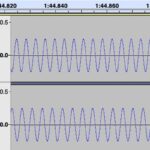The short answer is no. Binaural beats are not dangerous for your health. There currently isn't any research that suggests listening affects your health in any way.
The effect on the brain as a result of listening to binaural beats occurs naturally. It is considered an auditory illusion, a false perception of sound.
Below we'll discuss how this works and exactly what happens inside your brain when listening to these frequencies.

How it Works
We've written extensively on how binaural beats work, but for context let's briefly describe the process here.
Listening to binaural beats is a form of brainwave entrainment. The process beings with specific frequencies sent to the ears through headphones. This encourages the brain to produce brainwaves at a particular frequency.
The brain hears two frequencies, one in the left ear and one in the right ear.
When these frequencies are received by the brain, it perceives a phantom frequency, or third tone. It's phantom because you don't hear it. It is perceived.
This phantom frequency is the mathematical difference between the tones sent to the left and right ears. So if those are 205 Hz and 210 HZ, the difference would be 10 Hz.
The brain would follow along at 10 Hz and produce brainwaves at this frequency.
What This Does to the Brain
The way the brain responds in this process is perfectly natural. Our brains are designed in this way.
The auditory phenomenon was discovered by a Prussian physicist and meteorologist named Heinrich Wilhelm Dove. Further research was conducted later on by biophysicist Doctor Gerald Oster , who documented more about the process and its potential use in the medical field.
You are not harming your brain when listening to binaural beats; you are encouraging the brain to move into a particular state, to produce a specific type of brainwave.
There are 5 main brain states we refer to when talking about brainwaves. They are as follows, with a few associated benefits in brackets:
- Delta (deep sleep, healing, pain relief)
- Theta (REM sleep, deep relaxation, meditation)
- Alpha (relaxed focus, stress reduction, positive thinking)
- Beta (high level learning, problem solving, analytical thinking)
- Gamma (peak awareness, transcendental states)
It's important to note that you don't produce one type of brainwave at a time. If you were to take a snapshot of your brainwave patterns at any time you would see a cross section of different brainwaves.
However, it is usually the case that one state is more dominant than the others at a particular time. For example: when deeply relaxed, you are most likely producing an abundance of theta brainwaves.
So if we listen to a theta binaural beats track, we are encouraging the brain to produce brainwaves at this frequency, with the purpose of becoming relaxed.
Why It Isn't Dangerous
Binaural beats are harmless sound waves.
As humans, we are exposed to sound frequencies all the time. Many of us sit and listen to music with headphones on while we work for long period of time, exposing ourselves to frequencies of all different kinds.
Some people listen to dance music with rumbling bass-lines for hours, and others to music with soaring guitars. This all has an effect on the brain and changes the brain state, causing it to produce different brainwaves.
Humans hear sound waves made up of different frequency levels throughout the day. Sounds come from all directions of the natural world: from animals and the elements.
But not all frequencies are audible to humans. The human hearing threshold is limited, and generally cited as 20-20,000 Hz.
We are constantly exposed to inaudible frequencies through devices such as phones, microwaves, 4G/5G and WI-FI. There is some evidence that such frequencies may be harmful for health, but no such similar evidence for binaural beats (1).
How Binaural Beats Could Harm Your Health
There are a couple of ways listening to binaural beats could potentially harm your health. However, these would be caused by the user rather than the music itself.
- Listening at an excessively high volume.
- Listening in excess, for prolonged periods.
As with any type of sound, exposure at a very loud volume could cause temporary or long term hearing damage.
This is far more unlikely to happen listening to binaural beats music than with rock or dance music – which people tend to listen to at a very high volume – and even less likely to happen when listening to binaural beats on their own without a music overlay.
This is because the overlay is usually ambient and meditative, using soft sounds and natural ambience. And when listened to without a music overlay, binaural beats generally sound like a low fidelity tone, a hum / vibrating sound.
Listening to any type of music for too long, particularly with headphones on, may cause some people a headache, and even the development of tinnitus (2).
In Summary
Binaural beats music is a popular form of sound therapy. They help people with anxiety, focus, sleep, pain relief, tinnitus and more.
If you stumble across any alarmist articles online suggesting that binaural beats are dangerous then you can pretty much be certain that the point of the misinformation is to divert your attention elsewhere.
There are numerous studies that back up the effectiveness of binaural beats and thousands of users to attest to the benefits.
You can listen to binaural beats responsibly by simply setting the volume to a moderate setting, and by limiting your daily use to 3 sessions or no more than an hour each a day.
This is not because listening to more than that will harm you, but because this is more than enough usage to witness change in your desired area. As previously mentioned, it is also advisable to not overuse headphones, and to not listen to music loudly for long periods of time.
There is no evidence that binaural beats are dangerous for your health. This is a naturally-occurring music therapy discovered 180 years ago; now widely used by meditators, therapists, and individuals all over the world.










Hi James,
I’m wondering if you can comment on the comments below made by this neurofeedback tech.
What are the potentially negative effects of using binaural beats?
I have shared this before in answer to another question about binaural beats, but it feels relevant here as well;
I used to be a neurofeedback tech and so have a bit of an (unpopular) inside scoop. The thing is — binaural beats can/do work. What goes undetected however are the side effects. Binaural beats force our brains to generate this or that brainwave, depending on what the listener wants to achieve. A few crucial aspects unfortunately go unnoticed by most:
There is no distinction with beats as to which lobe(s) you want to increase such and such brainwave frequency — so instead of a targeted area it becomes a whole brain experience. This is not desirable. A balanced brain has ratios and balance between all the frequencies and the rest of the brain’s electrical activity. Truly to achieve the desired outcome 1 or maybe 2 lobes could actually use more of that particular frequency and less of others.
When people decide to listen to beats and increase whichever brainwave(s) they think they need, they have no idea exactly what amplitudes are already present. There is only a finite amount of electricity in each of our lobes; increasing certain frequencies means less amplitude given to others. This can knock things really out of whack while at the same time achieving the desired goal. So… one might sleep better but also find greater foggy thinking or depression develops and not correlate the two.
Because binaural beats force our brains to generate more of the chosen frequency (again chosen by suspected symptomology not chosen by brain mapping and observing actual amplitudes and ratios) the new patterns formed often become very hard to shift afterward. If you think of it as electrical impulses traveling neural pathways are kind of like walking a path through a forest… if one walks that route enough the path becomes more established. When it’s more established, folks are more likely to stick to that path instead of forging a new one. Eventually that path might become a road or a highway where all the traffic takes just that route. By listening to beats one is sending electrical impulses along neural pathways until that becomes the established route. In my former career we periodically saw folks who had been listening to beats and created greater imbalances than they originally had (most of us have some degree of imbalance due to real or perceived trauma… it’s our brains way of surviving… a story for another post perhaps) these forced imbalances saw little improvement even after months of treatment. Our technology was more geared to encouraging the brain to remedy itself voluntarily rather than by forcing it.
Binaural beats seem to only raise or increase activity not relax over active frequencies as far as I know. It’s a bit like adding speed to keep going rather than taking a needed nap. Or developing a resistance to medication and needing higher doses. Just more stimulation to other frequencies instead of reducing what is already too high in the first place.
So while you may achieve what you are hoping for by listening to them, in my opinion they are actually doing us a disservice. Very very few people have this sort of inside perspective and I personally wish more would speak out.
Hi Chris,
Thank you for sharing the insights provided by the former neurofeedback technician. We appreciate their perspective and the opportunity to engage in a meaningful discussion about the effects of binaural beats.
While we respect the concerns raised, there are several points in their comments that do not align with current scientific understanding or the established principles behind binaural beats and brainwave entrainment. Let’s take a closer look and address these issues in detail.
1. Binaural beats force our brains to generate this or that brainwave, which is undesirable because it affects the whole brain, not specific lobes
Binaural beats do not “force” the brain to do anything. Instead, they encourage the brain to synchronize with a perceived frequency difference between two tones, a process known as entrainment. This is a passive phenomenon where the brainwaves naturally align with external rhythms.
Furthermore, binaural beats affect the auditory cortex and are not capable of targeting specific brain lobes. Claims that the “whole brain” is influenced are misleading because brainwave entrainment primarily impacts localized regions associated with auditory perception and does not override the natural functioning of other lobes.
2. There is only a finite amount of electricity in the brain, so increasing one frequency diminishes others, causing imbalances.
The concept of “finite electricity” in the brain is overly simplistic and inaccurate. Brainwave frequencies (e.g., alpha, beta, theta) represent different patterns of neural activity, not limited electrical resources. These patterns naturally coexist and fluctuate throughout the day depending on what the brain is doing (e.g., focusing, resting, or processing information).
Listening to binaural beats at a specific frequency does not “drain” other brainwave frequencies but temporarily enhances synchronization at that particular frequency. This is a natural response and does not fundamentally alter the brain’s capacity to shift between states.
3. Binaural beats create lasting imbalances by forming rigid neural pathways.
There is no evidence to suggest that listening to binaural beats establishes permanent neural pathways or creates lasting imbalances. Neural plasticity –the brain’s ability to adapt and reorganize itself – is a well-documented process, and transient effects from binaural beats are unlikely to override this flexibility.
The comparison to neurofeedback again misrepresents binaural beats. Neurofeedback involves deliberate, repeated reinforcement to train specific brainwave activity, whereas binaural beats are passive and require regular use to benefit from the effects.
4. Binaural beats only raise activity and don’t reduce overactive frequencies.
This claim is unsubstantiated. Research shows that binaural beats can influence different states depending on the target frequency. For example, lower frequencies (e.g., delta or theta) are associated with relaxation and sleep, while higher frequencies (e.g., beta) can improve focus and alertness.
Binaural beats do not “stimulate” or “suppress” frequencies in a mechanistic way. Instead, they encourage the brain to synchronize with the frequency, which may either calm or energize the listener depending on the context.
5. Binaural beats cause harm and long-lasting negative effects.
No robust scientific studies support the idea that binaural beats cause harm or lasting imbalances in brain activity. On the contrary, multiple studies highlight the potential benefits of binaural beats for relaxation, stress reduction, sleep improvement, and even cognitive performance. These effects are generally transient, not long-term or disruptive, and continued benefit requires continued or periodic use.
If negative effects have been observed in some neurofeedback patients, these could stem from underlying conditions, or other unrelated factors, not from binaural beats themselves.
Thank you.
James,
Thank you for this detailed response. I’m considering trying them and am doing my due dilligence prior to getting started.
Chris
You’re welcome, Chris.